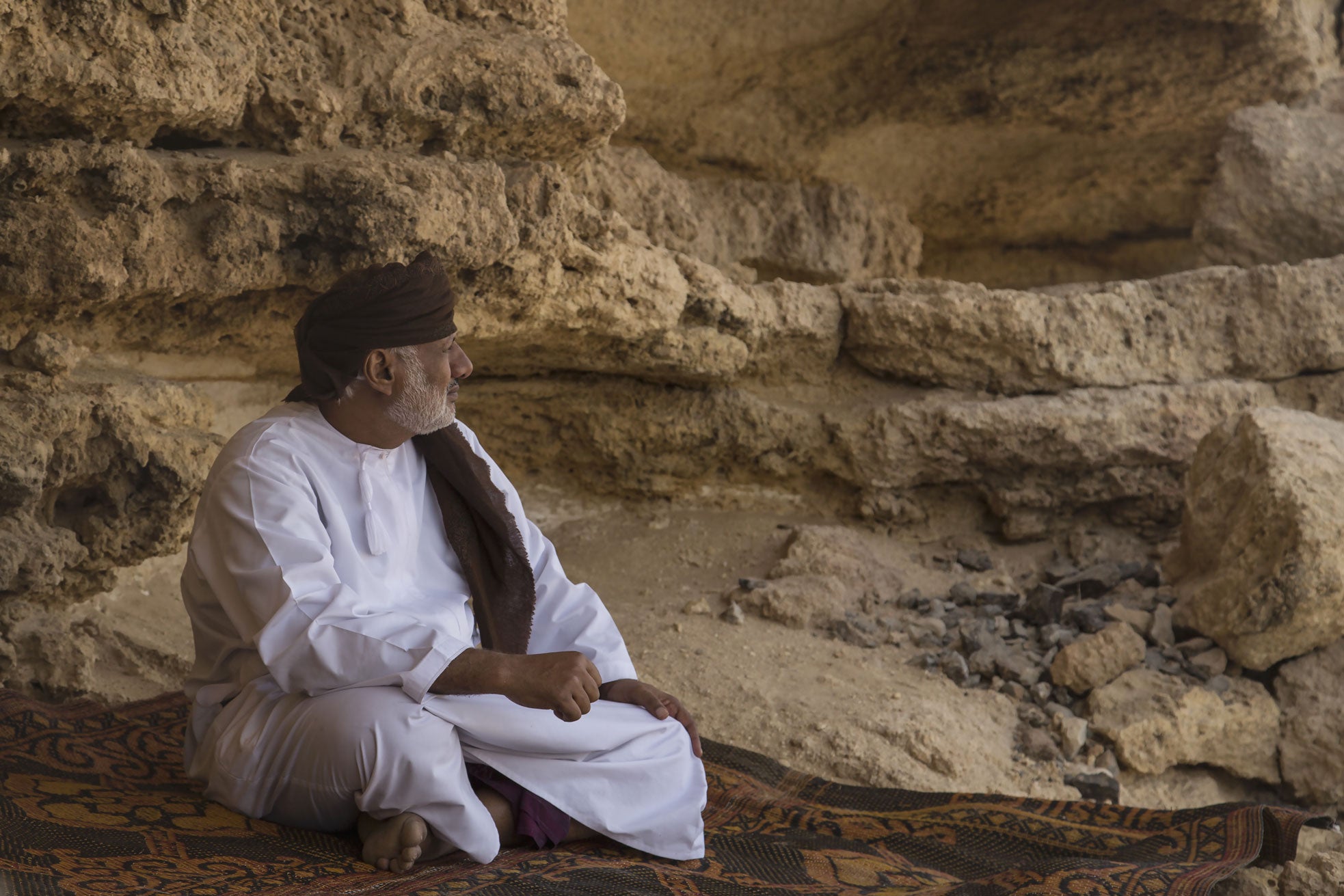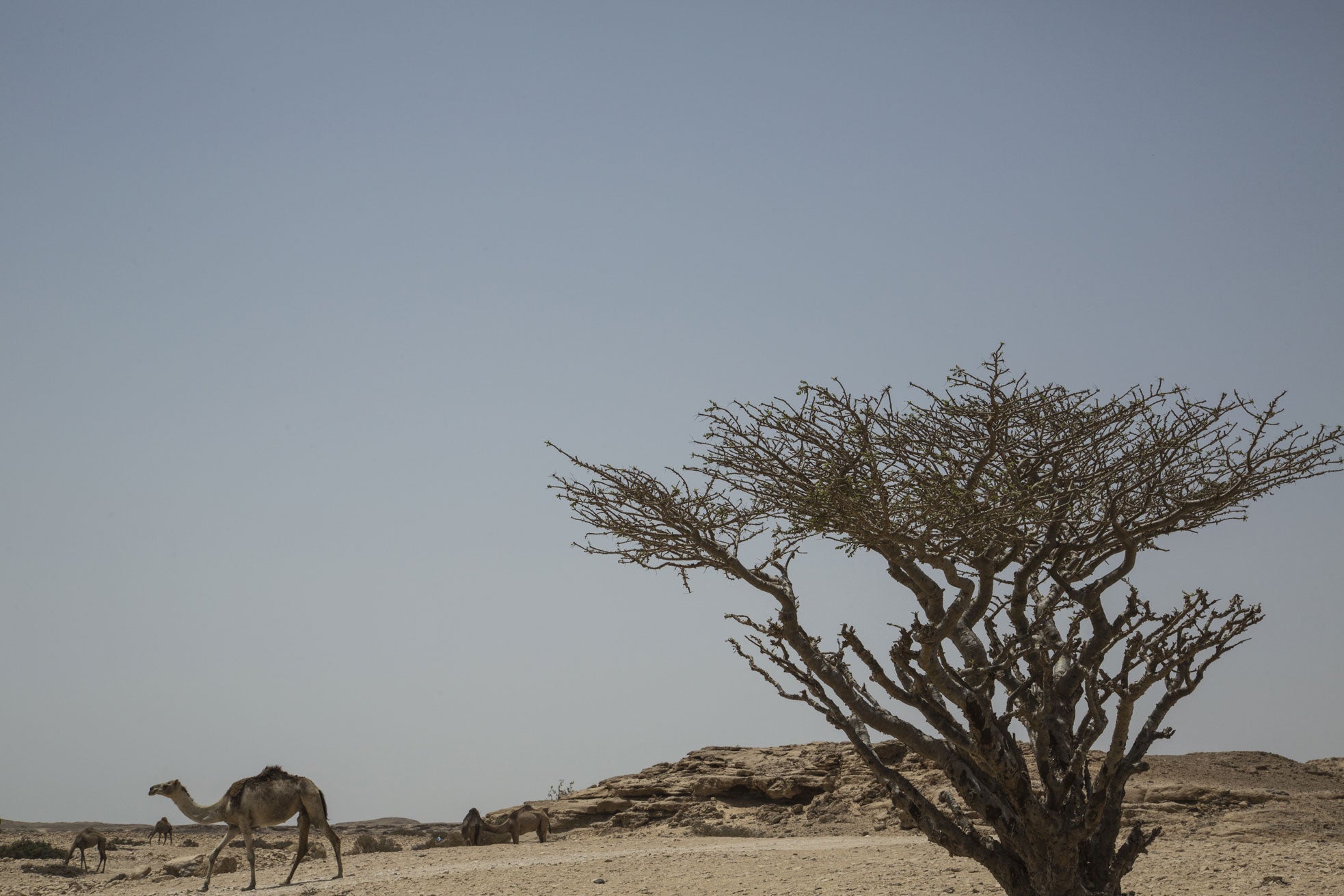HARVEST SEASON
THE MYTHIC MILK
DHOFAR, OMAN
Scroll to explore
The Story
IN CONVERSATION WITH SUHAIL AL-MAHRI
BEDOUIN GUIDE IN SALALAH, OMAN
Suhail Al-Mahri is a Bedouin guide living in Salalah, Oman. Al-Mahri is from Oman’s largest tribe of Bedouins, the Al-Mahri, from which he takes his name. Bedouins usually spend harvest season taking shelter from the heat, wind or even rain within the caves of the wadis where the resin is found. Al-Mahri, along with many of his tribesmen, continues to believe in the medicinal and mythic attributes of frankincense, known locally as Al-Luban, meaning “from milk.”
 This work is done with
This work is done with It was
SUHAIL AL-MAHRI, BEDOUIN GUIDE
known as White Gold,
because it was highly
valued.
S+O — WHAT IS THE SIGNIFICANCE OF THE FRANKINCENSE TREE TO THIS AREA OF OMAN?
Al-Mahri — There are other areas in the world that are capable of growing frankincense, like Somalia or Yemen, but experts will agree that the best varieties of frankincense come from the Dhofar region of Oman.
This has been the same for thousands of years, when the Luban was known as White Gold because it was highly valued.
S+O — WHAT IS THE HISTORY OF FRANKINCENSE THAT HAS MADE IT AN ENDURING PART OF THE CULTURE UNTIL TODAY?
Al-Mahri — I think most people would know the story of the three wisemen who brought gifts to Jesus. They brought gold, myrrh and frankincense. It was so desirable that people went to great lengths to trade it.
The caravans would take the frankincense from here down to the harbor on the coast where it would be transported on dhows across the gulf to the Red Sea. Alternatively, camel caravans would carry it over land from here to Ubar, whose lost city is known as "the Atlantis of the Sands.” From Ubar it would travel to the West, through the Arabian Peninsula, until it reached the trading post in the Saudi city of Jeddah, arrived at Jordan and crossed again the Mediterranean port cities and towns in Egypt.

S+O — WHY WAS FRANKINCENSE IN SUCH HIGH DEMAND IN PLACES LIKE EGYPT?
Al-Mahri — Frankincense was very expensive and highly coveted among the wealthy elite of Egypt, especially the pharaohs. It was used in elaborate burial rituals, often as part of embalming practices, and burned alongside their bodies to accompany them to the afterlife. It isn’t really used this way anymore, but it is still prominent in religious rituals in some places. Its value has gone down significantly since the second World War, but it is still appealing in our local Bedouin culture.
S+O — WHAT ARE THE TRADITIONAL USES IN THE BEDOUIN CULTURE?
Al-Mahri —The frankincense tree was considered a holy tree. We still believe this today. It is used on many occasions , particularly for medicinal purposes. We believe it is good for the overall health of the body. Taken orally, it kills stomach bacteria and germs. It is also good for the lungs and gets rid of bad breath, so we chew it like a gum. The elders especially believe that frankincense keeps devils and the bad spirits away from children and animals. So, every morning and evening when the animals come to the campsite, frankincense is burned and the area fills with smoke that is said to protect against the evil spirits.

S+O — HOW ARE THE TREES HARVESTED?
Al-Mahri —The harvesting season starts in April and ends in September. The harvesting is done over three stages of cutting during that period. For the first cut, we use our traditional tools and carefully chip away at the bark of the tree to expose the sap. After three weeks, we come back and collect the sap, and make a second cut in the same place where we had carved the bark before. The second cut will produce more sap of better quality. Then, it is left once again for another two to three weeks. Finally, we return and collect the remaining sap. If the sap is dry, we put it in a bag. Otherwise, it will be dried at the camp.



S+O — HOW CAN ONE TELL THE DIFFERENCE IN QUALITY?
Al-Mahri —There are four grades of frankincense. These are determined by the aroma and color of the resin. The best one is known as Hojari, which is grown in Eastern Dhofar, and it is distinctively white in color and clear. The second grade , Najdi, is grown locally in the Dhofari rocky desert. Then there are the lesser-quality frankincense varieties, Shari and Shabi, respectively grown in other regions. The colors become increasingly darker as the quality diminishes. I believe any grade is good for burning, and the different scents are difficult to distinguish. But for traditional medicinal purposes the two top grades, especially Hojari, are ideal .
S+O — HOW WOULD YOU DESCRIBE THE UNIQUE LANDSCAPE OF THE WADI WHERE FRANKINCENSE IS HARVESTED?
Al-Mahri — We have a very unique climate encircling the Arabian Peninsula here in Dhofar. The Khareef monsoon season begins at the end of June until the middle of September. During these months, it actually rains in the desert and the landscape turns green. People come from all around to escape the excruciating heat of the rest of the peninsula, and marvel at the beauty. I think it’s beautiful all year round . We have everything here from the sea shore to the mountains, to the rocky desert and the vast sand dunes. The nature is so diverse and wonderful. And for us, it’s a place to call home, literally. If you ask me, I would prefer to sleep in one of these caves than a five star hotel. It soothes your soul to feel connected to nature. The peacefulness and quiet is everywhere . You can’t hear anything except for the wind and yourself.


Credits
Photography by Clement Jolin
Film by Mark Bliss
Special Acknowledgments - The Al Baleed Resort by Anantara Concierge and Marhaba Dhofar Tours
The Objects
Exclusive Edition 019 OMANI FRANKINCENSE
Frankincense from the Boswellia sacra tree in Dhofar, Oman is considered to be the best quality in the world and long revered by the ancient societies of our world. The resin can be used for medicinal purposes, such as a frankincense water tonic, digestive aid and chewing gum, or as more commonly used as incense.
The Destination
DHOFAR, OMAN
The Dhofar region of Oman offers a diverse landscape of supreme beauty stretching from the Arabian Sea coastal shores to the Rub’ al Khali, the world’s largest sand dune area. The area yields the best quality grades of frankincense. Visitors come from all over Arabia to see the spectacular greening of the mountains and low-lying areas during the Khareef season between July and September when the rest of the peninsula is unbearably hot. Local tour operator Marhaba Dhofar can assist with customized overnight excursions within the incredible landscapes S+O witnessed on our story travels.



